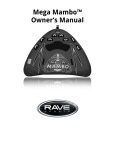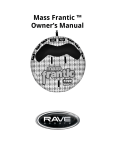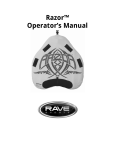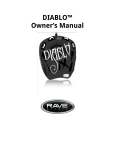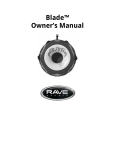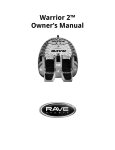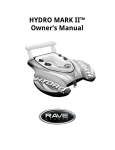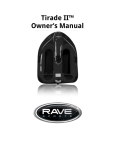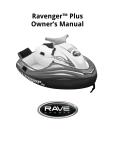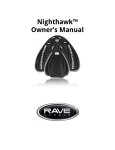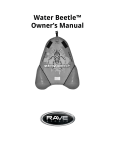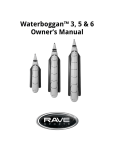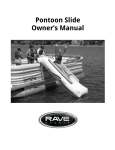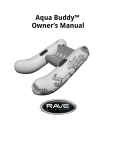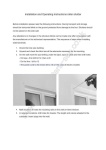Download RAVE Water Sports Equipment User Manual
Transcript
Mambo™ Owner’s Manual Product Instructions and Warnings (continued) or handles. Never wedge your hands or feet under the cover or between the cover and the tube. • Never attempt jumps or dangerous tricks with your tube. If more than one tube is being towed, avoid collisions with other tubes. • Scout the area before use to avoid any debris or obstacles that might present a safety hazard. • Know your own limits. Stop when you are tired. Act responsibly. Be in good physical condition and cautious in your use of this or any other towable tube. • Check the rope and connectors for frays, cuts, sharp edges, knots, or wear before each use. Discard rope if any such condition exists or if rope appears to be worn. Such conditions may lead to breaks • Do not use tow rope with elastic or bungee material to pull riders. Such an addition can break or stretch, which may lead to injury of users or boat occupants. • The stress on the rope is different than the stress on the tube, and will vary with the weight of the riders, design and surface area of the tube. • Rope is subject to deterioration when exposed to direct sunlight. The life of the product will be extended when stored away from sunlight. • The tow rope should be replaced when signs of deterioration appear, indicated by the existence of discoloration, wear, fraying or unraveling. • Do not add hardware or attachments that are not otherwise supplied by the manufacturer. ! WARNING ! WARNING USE OF THIS PRODUCT AND PARTICIPATION IN THE SPORT OF TUBING INVOLVES INHERENT RISKS OF INJURY OR DEATH. Do not use at speeds that exceed the skill of the rider. Boat speed should never exceed 20 mph for adults and 15 mph for children. This product should never be used by children except under adult supervision. This is not a personal flotation device. Always wear a U.S. Coast Guard approved Type III (PFD) vest. Never place wrists or feet through handles or towing harness. Ensure tow rope is clear of all body parts prior to or during use. Rider should keep feet out of the water. Watercraft driver is responsible for the ride since the tube cannot be controlled by the rider. Always have a person other than the driver observing the rider. Watercraft driver should avoid excessive speed or sharp turns which might cause the tube to flip over abruptly, resulting in serious injury to the rider. ! WARNING Do not tow in shallow water or near shore, docks, pilings, swimmers or other boats. Do not exceed the manufacturer’s recommended number of riders for your particular tube. Use a tow rope of at least 1,500 lbs. average tensile strength for pulling a single person; 2,375 lbs. average tensile strength for pulling two people; 3,350 lbs. average tensile strength for pulling three people; and 4,100 lbs. average tensile strength for pulling four people on an inflatable tube. The tow rope should be at least 50 feet in length but not to exceed 65 feet. Do not operate watercraft or ride under the influence of alcohol or drugs. Read Operator’s Manual before use. Your equipment and your tow rope: • Inspect all equipment prior to use. Check tube and attachment point prior to each use. Do not use if damaged. • Always wear a U.S. Guard Type III (PFD) vest. • Rope should be attached to the watercraft in an approved fashion with hardware designed for pulling. Refer to your watercraft manual for instructions on proper tow rope attachment. • Tow ropes stretch during use. If a rope breaks or is suddenly released, it can snap back into the watercraft. Warn all riders and occupants of the danger of the rope recoil. • When in the boat, keep away from the tow rope to avoid injury. Passengers can be hit or become entangled in the rope. • Inspect tow rope and its attachments before using. Do not use tow rope if frayed, knotted or damaged. Replace when signs of excessive deterioration are indicated by discoloration, broken filaments, unraveling or other obvious signs of wear on the rope or hardware. • Use proper tow rope for the activity. • Ensure rope is clear of all body parts prior to starting out or during use. • Keep persons and ropes away from propeller when engine is running, even in neutral. Should rope become entangled in propeller, SHUT OFF ENGINE AND REMOVE IGNITION KEY BEFORE RETRIEVING ROPE. When You Ride: • Attempting land or dock starts can increase the risk of injury or death. USE THIS PRODUCT ONLY ON WATER. • Always remove any slack in the rope between watercraft and rider before starting. Sudden shock loads may cause injury to the rider or failure of rope, resulting in snap-back or breakage. • Do not ride in shallow water, near shore, pilings, docks, rafts, swimmers, other boats or other obstacles. Such obstacles are examples of risks that are inherent in the sport. • The driver and rider must watch for and be able to stop or turn to avoid obstacles. • Always ride in control and at speeds appropriate for your ability. Ride within your limits. Follow instructions on tube for safe speed limits. • Do not ride over ramps or jumps. • Falling and the injuries that may result are inherent risks in the sport. • Use a flag to signal to others that a rider is in the water. • Driver must use extra caution approaching fallen rider and keep eye contact on fallen rider at all times. • Put the boat in neutral when near a fallen rider. Turn the engine off when people are getting in or out of the boat, or while in the water near the boat. Do not operate watercraft or ride under the influence of alcohol of drugs. Inflating Instructions CAUTION: DO NOT OVER-INFLATE. Inflate only until firm. Use of an air compressor or over-inflation can rupture the tube beyond repair, voiding the warranty. Step 1 Lay towable face up on a flat surface. Make sure there are no sharp objects under the product that might puncture the tube. Step 2 Ensure rear zipper and Velcro flap are fully closed before inflating. Step 3 Locate the Boston valve underneath the square flap on the top of the cover towards the left rear section of the tube. Inflate using a hand pump or powered inflator until it is firm and the cover is reasonably taut. Check cover positioning during inflation and adjust if necessary. Install valve cap, ensuring it is seated squarely and fully. Note: A firm and fully inflated tube will perform better on the water than an under-inflated tube and is less subject to damage. Use a hand pump to top off, if needed, to obtain this firmness. However, do not over-inflate. Inflate only till firm. Note also that the air pressure in the tube will fluctuate depending on air and water temperatures. Adjust the air pressure in the tube accordingly throughout the day to maintain proper firmness during use. Step 4 Attach the tow rope (not included). Important: Loop end of rope MUST pass through hole of the quick-connect prior to wrapping loop around hooks. Inspect condition of molded tow point prior to each use. Do not use if it shows signs of damage, cracking or breaking. To Deflate: • Unscrew entire valve body from base. Towing Recommendations For best performance and stability in bumps and turns: STAY CENTERED ON THE TUBE. Let the tube do the work in sharp turns and over bumps. The upturned wings will allow you to slide and roll over boat wakes without shifting your weight to the inside. Keeping your weight centered will also allow for level flights and landings if you hit big bumps. Troubleshooting Air chamber(s) won’t hold air: • Check main Boston valve to ensure plastic ring is not caught under the seal or cap. • Check for holes in bladder following the procedures in the “Repair” section. Cleaning and Storage • When the inflatable product is not being used, we recommend that you store it in a covered, shaded area. This will help protect it against ultraviolet (UV) rays and extend the life of the product. • Clean the inflatable completely with a mild soap and fresh water. NEVER USE PETROLEUM BASED PRODUCTS OR SOLVENTS FOR CLEANING. • Product should be completely dry and remain dry while stored. • Roll the product loosely and place in a vented storage bag or container. • Store in a cool, dry location. Do not store product directly on concrete surface. Place mothballs around stored inflatable to keep mice and insects away. • Secure the product to prevent unauthorized or unsupervised use. Repairs For Minor Holes or Tears: • Remove the inner bladder from the cover. • Inflate the tube and locate the leak by spraying the tube with soapy water. Bubbles will appear where there is a leak. • Determine the hole size and cut a circular patch ½ - 1 inch wider than the hole. • Remove air from the tube and dry tube completely where the patch is to be applied. • Peel off paper back from patch, apply repair patch to area and work out any air bubbles from beneath the patch. • Apply weight to the patched area for one hour before reinflating. • Put the bladder back into the cover. NOTE: Ensure the outer edge seam of the bladder is aligned with the cover seam and is spread out evenly within the cover. A misaligned cover can cause distortion and less than optimal performance of the tube. RAVE Sports Raft Water Sports










